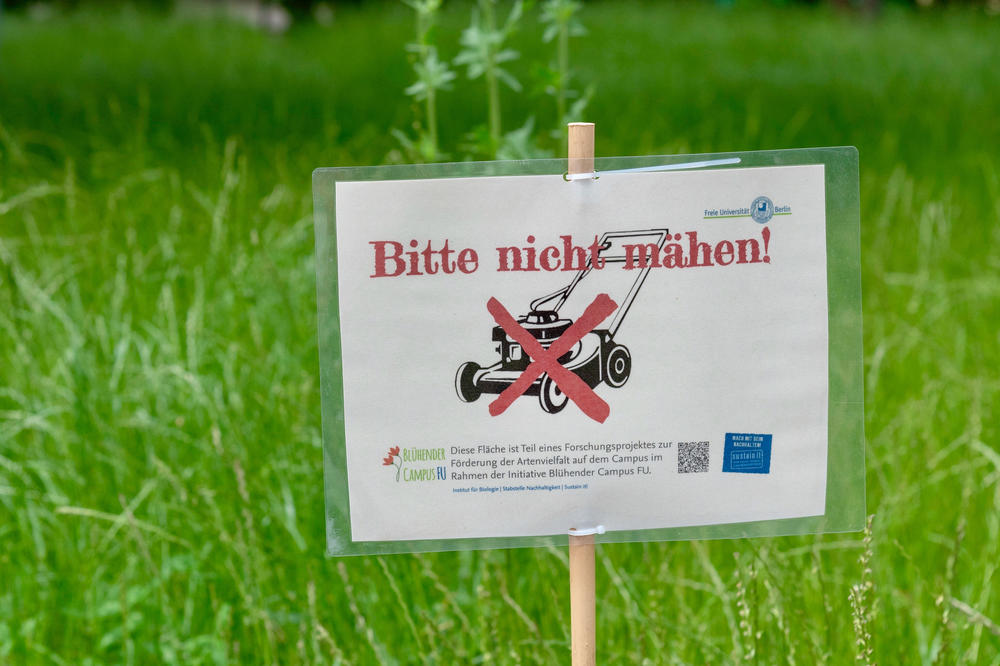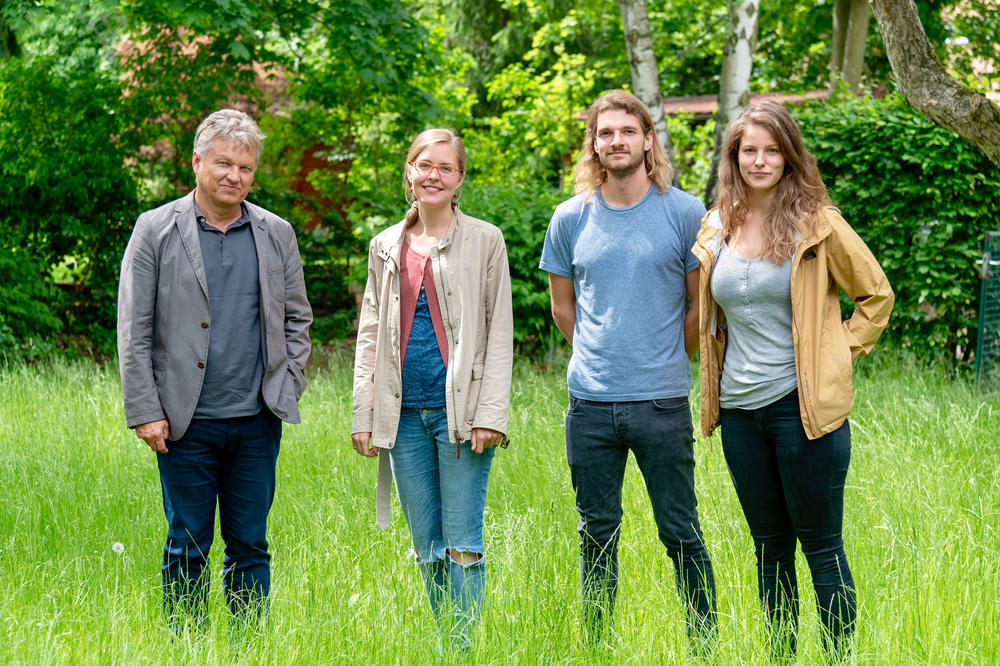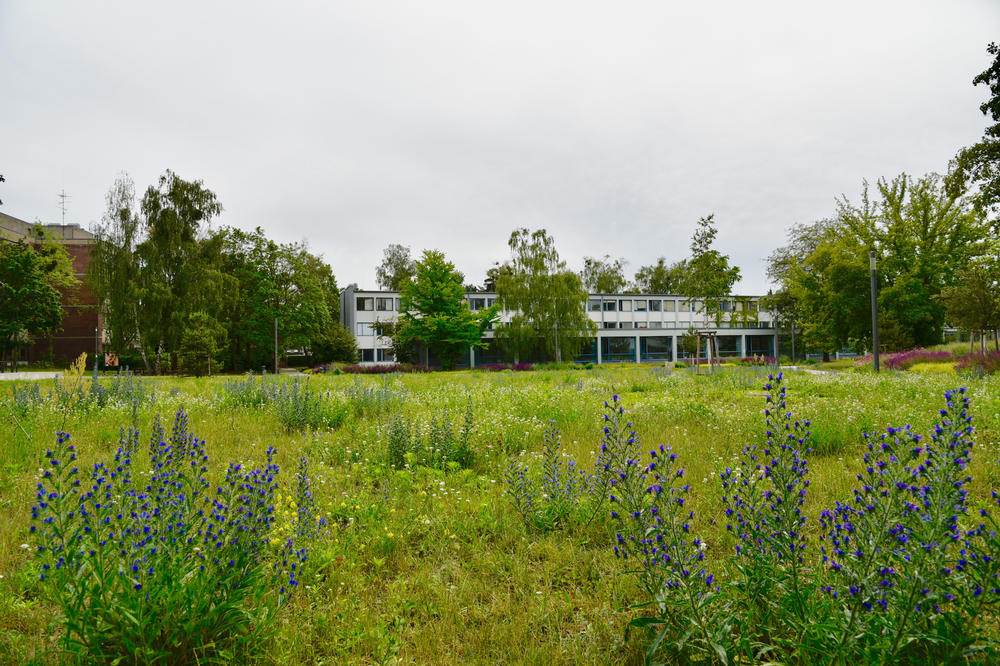Where’s the Lawn Mower?
The newly launched “Blühender Campus” (Blossoming Campus) project aims to cultivate greater biodiversity in the green areas at Freie Universität.
Jun 14, 2019
There are increasing signs that we are living in an age of rapid insect die-offs: Over the past 30 years, biomass of flying insects alone has decreased by 70 to 80 percent, even in protected natural areas. “To understand the sheer scope of this finding, you have to think about the role of insects when it comes to life on this planet,” says Sophie Lokatis. “They are responsible for pollinating 80 percent of all blossoming plants, and beyond that, many kinds of food crops, such as fruit trees and some crops planted in fields.” More than 60 percent of all animal species that have been described are insects. In nature, they play a key role, particularly as decomposers that generate new nutrients and feed them back into the life cycle. “When insect populations decline, it triggers a chain reaction that changes the food chain for many organisms so dramatically that there is a threat to the stability of global ecosystems.”
One of the main causes of the sharp drop in population is loss of habitat for insects. The newly established “Blühender Campus” (Blossoming Campus) initiative aims to change that, right in its own backyard: on the Dahlem campus of Freie Universität. The initiative was established by researchers from the Department of Biology, Chemistry and Pharmacy, among others.
Lokatis is one of them. A doctoral candidate in the Ecological Novelty working group, she advocates the creation of biodiverse habitats even in areas used by people, saying, “Urban settlements are becoming more and more important to animals and plants because as agriculture grows more intense, more and more plant species are being squeezed out.” Sustainable management of grassy spaces could offer a refuge for many plants, insects, and birds in the city. “The green space of Freie Universität on the Dahlem campus offers great potential for this,” adds Andreas Wanke, head of the Sustainability & Energy Unit. And, animals and plants aren’t the only ones to benefit, he adds. For people, too, a meadow of wildflowers with brimstone and peacock butterflies can be more attractive than a close-cropped lawn.
Supporters of biodiversity on campus: Andreas Wanke, Sophie Lokatis, Simon Huesmann, and Anja Proske
Image Credit: Sören Maahs
Silent Lawn, Buzzing Meadow
A large portion of the Dahlem campus is made up of green space, which also shapes the image of the campus. Unfortunately, though, most of these green islands between the university buildings don’t look as Lokatis would like them to. “A neatly trimmed lawn gives a tidy impression, but it doesn’t do a thing for biodiversity,” she says.
In early May, eleven test areas around campus, ranging in size from 100 to 400 square meters each, were reserved for the “Blossoming Campus” pilot project. Two graduate students in the Biodiversity, Evolution, and Ecology program are supporting the project with scientific comparison studies. To document the effects of mowing on biodiversity, the students, Anja Proske and Simon Huesmann, are comparing the species composition in the unmowed test areas with that in the control areas, which undergo regular mowing. Their aim is to find out how the changed care concept affects plant and insect diversity.
Pollinators Need Flowers
Cutting meadows causes insects to lose their food sources, year after year. Mowing too early and too often prevents the plants that make up the lawn from blooming, Proske explains. A short lawn offers no food for insects, nowhere to nest, and nowhere to spend the winter. “But it’s easy to change that: Wherever lawns aren’t used for rest or recreation, you can let them grow into meadows.” These flourishing wild grassy spaces would also help the 300 wild bee species living in Berlin, half of them threatened or endangered, to survive. “Ideally,” Huesmann says, “there should always be something in bloom, from early spring to late fall.”
Blooming meadows require less care, and mowing practices geared toward protecting nature are easy to implement and inexpensive, Lokatis says. These kinds of space are also more effective at absorbing heat during hot summers, and they filter out more particulates from the air, so they have a positive impact on the local microclimate. A wildflower meadow is never fertilized. “Mowing takes place twice a year at most, after the main blossoming season, between July and August.” Previously, the green space on the Freie Universität campus was mowed as much as nine times a year.
Ecological and aesthetic qualities can be achieved in the same meadow
Blossoming meadows would also bring a touch of color to the campus. “Sadly, I do run across a certain level of opposition toward natural meadows in the city from time to time. Some people view them as unkempt and overgrown,” Lokatis says. The project’s initiators aim to counter these kinds of criticism through campus-wide educational outreach. Wanke is confident that it will be a success. “More and more people are moving away from the aesthetic ideal of the English lawn, and they are open to more ecological landscaping practices.” Another key aspect of the initiative is that it is a classic “living lab” project, which brings researchers, students, sustainability initiatives, and the university administration together. An initiative with this broad a basis, and one that is also supported by commitment to civil society, is a stroke of luck for any university, Wanke says.
To keep species-rich meadows from being misunderstood as signs of lack of maintenance, Lokatis and her fellow campaigners advocate putting a visual frame around the wildflower meadows. A mowed strip along the path could show that the meadow is indeed being cared for and has not been left to go to seed. There are plans for informational signs to explain to members of the university community, local residents, and passersby how important wildflower areas are to the natural world.
The initiators behind the campaign agree that transforming mowed areas into thriving wildflower meadows will take some time. Without a far-reaching redesign – removing the turf and re-seeding the soil – the migration of flowers typically found in meadows will depend on seeds carried on the wind from the local area. Still, initial successes are already visible. The meadow in front of the Japanese Studies Institute at Hittorfstraße 18, for example, and at Thielallee 63, between the departments of law and biochemistry, is home to a thriving population of daisies, campion, bellflowers, common poppies, bird vetch, yarrow, meadow sage, and wild carrot. These plants aren’t just pretty to look at. They’re also highly important in terms of biodiversity – and they are a coveted source of food for wild bees.
This text originally appeared in German in the campus.leben online magazine published by Freie Universität Berlin.
Further Information
The “Blossoming Campus” initiative would like to invite other members of the university community to participate. Prospective participants are welcome to contact the Sustainability & Energy Unit.
The initiative was launched by Professor Jens Rolff, Sophie Lokatis, the sustainability initiative Sustain it! and the Sustainability & Energy Unit at Freie Universität. The goal of the broad-based project is to bring stakeholders who are dedicated to promoting biodiversity and nature on campus together across the boundaries of individual disciplines and institutes. Participants now also include employees, scholars, scientists, researchers, and students from the fields of geography, bioinformatics, education, political science, veterinary medicine, the Center for Digital Systems (CeDiS) at Freie Universität, and the Berlin Botanic Garden.



